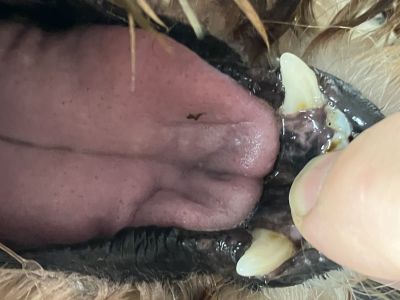
Posted By:
The 3rd June was a typically busy Saturday at our Shepton practice. We had seen our fair share of dogs with dodgy tummies, cats with scratches, and rabbits feeling run down. In amongst these were the routine booster vaccinations, which I always enjoy as it is a time for me to get to know owners better, and to remind our patients that coming to the vets can be a pleasurable experience, with fuss and treats and only a tiny sting at the end.
Which leads me to an interesting case. In the diary for the afternoon I saw that Bob the Miniature Schnauzer was coming in with “something wrong with his mouth”. When he arrived, it was obvious there was a problem. He was drooling and he really didn’t want to close his mouth. I immediately recalled cases of pieces of stick wedged between dogs’ teeth, dislocated jaws and even tetanus, and I prepared myself to admit Bob for treatment under anaesthetic or sedation.
It was obvious that he was going to find a physical examination of his head uncomfortable, so first I concentrated on getting a really thorough history from his concerned owners. They told me Bob had been out in the garden with them for a little while. It was a hot sunny day and he hadn’t been rushing about so an injury was very unlikely. No dislocated jaw, then. He had had no recent injuries and is a good boy who isn’t prone to scavenging or chewing up things he finds. So tetanus was very unlikely too and a wedged stick not top of my list. But he had been snuffling in the long grass under a tree immediately before the problem started. I think we all started suspected a bee sting at this stage.
Bee stings are quite common in dogs, especially around the muzzle. I have long proclaimed that the first sign of Spring is a Boxer dog coming to the surgery with one side of his face swollen. Boxers are inquisitive, playful, and (I can say this as I have owned and loved a Boxer) not very bright. They love to play with buzzing bees, but invariably the bee gets caught up in their big floppy jowls and they get stung.
But Bob is a nice sensible Mini Schnauzer with no droopy chops. Very gently I lifted his head and had a good look around his lips, face, eyes and gums. And there it was! A whole bee sting, still stuck in his tongue! Poor Bob, it was really painful and every time he closed his mouth his tongue would have touched the roof of his mouth and made it worse. He was actually being very calm considering his predicament.
I used an anaesthetic spray to numb the surface of his tongue, waited a couple of minutes, then used tiny forceps to gently remove the sting. It really was well attached with its barbs. I don’t think many dogs would have let me do this without a bit of sedation, but Bob was incredibly brave and stoic. Perhaps he had realised he needed a bit of help, because as soon as the sting came away he looked much more comfortable and could close his mouth.
As in people, we need to be extra cautious with stings around the face in dogs. If the face and neck swell as a result of the sting then it can cause problems breathing, so we take no chances. I gave Bob an injection of corticosteroids to stop him getting an anaphylactic reaction to the bee sting, then sent him home with antihistamine tablets to take for the next couple of days.
I shall never forget the satisfaction or finding and removing that sting, and I suspect Bob felt the same way.
- Vet Polly
From our perspective, Bob's case was a fascinating and rewarding experience. Our dedicated team of veterinarians and staff members worked diligently to address his mouth issue and provide him with the necessary care and treatment. Our primary goal is always to ensure the well-being and comfort of our patients, and Bob's case exemplified our commitment to delivering exceptional veterinary care.
At Shepton Vets, we understand the importance of thorough examinations and detailed histories to accurately diagnose and treat our patients. Bob's owners' observations about his activities in the garden were invaluable in determining the likely cause of his discomfort. By actively listening to our clients and involving them in the diagnostic process, we aim to establish a trusting and collaborative relationship with every pet owner.
The removal of the bee sting from Bob's tongue required precision, delicate handling, and the use of appropriate anesthesia. Our experienced veterinarian Polly, expertly administered local anesthesia to ensure Bob's comfort during the procedure. We are proud of our team's expertise and their ability to provide gentle and compassionate care, even in challenging situations.
Our commitment to education and communication extends beyond the consultation room. Sharing Bob's case allows us to engage and provide valuable insights into veterinary care. We believe in the power of informative and educational content to empower pet owners and raise awareness about potential health concerns.
Bob's story is just one example of the exceptional care and dedication that defines our practice. We are honored to serve our clients and their beloved pets, and we strive to create positive experiences that make a lasting impact on both their lives and ours.
A short video of the extraction is up on our facebook and Instagram pages
Whilst on my visits I have been having several discussions...
As our feline friends get older there are a few conditions...
Another winter discussion group season is now behind...
©2024 Shepton Veterinary Group Ltd., All rights reserved.
Privacy Policy • Terms & Conditions • Cookie Policy